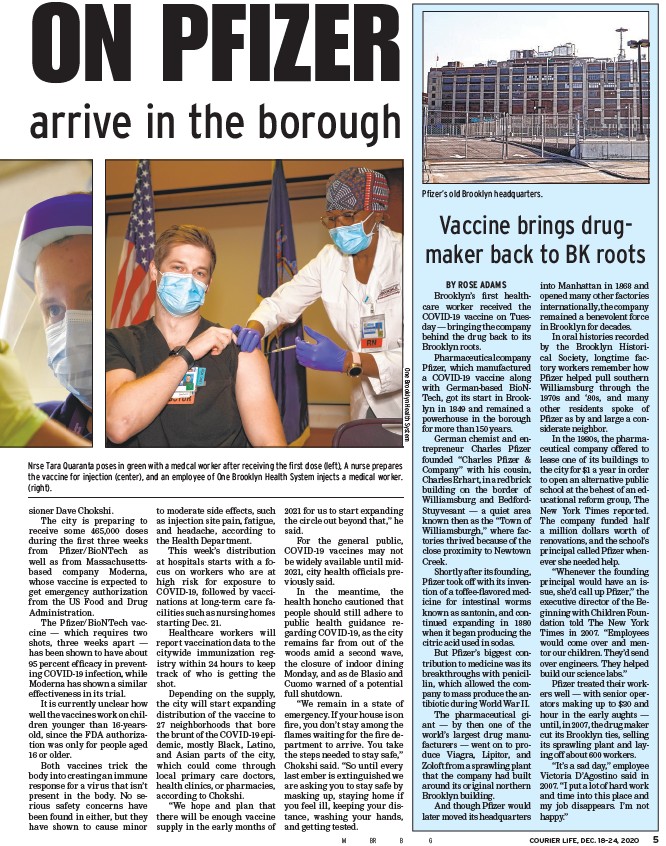
Pfi zer’s old Brooklyn headquarters.
ON PFIZER
COURIER L M BR B G IFE, DEC. 18–24, 2020 5
sioner Dave Chokshi.
The city is preparing to
receive some 465,000 doses
during the fi rst three weeks
from Pfi zer/BioNTech as
well as from Massachusettsbased
company Moderna,
whose vaccine is expected to
get emergency authorization
from the US Food and Drug
Administration.
The Pfi zer/BioNTech vaccine
— which requires two
shots, three weeks apart —
has been shown to have about
95 percent effi cacy in preventing
COVID-19 infection, while
Moderna has shown a similar
effectiveness in its trial.
It is currently unclear how
well the vaccines work on children
younger than 16-yearsold,
since the FDA authorization
was only for people aged
16 or older.
Both vaccines trick the
body into creating an immune
response for a virus that isn’t
present in the body. No serious
safety concerns have
been found in either, but they
have shown to cause minor
to moderate side effects, such
as injection site pain, fatigue,
and headache, according to
the Health Department.
This week’s distribution
at hospitals starts with a focus
on workers who are at
high risk for exposure to
COVID-19, followed by vaccinations
at long-term care facilities
such as nursing homes
starting Dec. 21.
Healthcare workers will
report vaccination data to the
citywide immunization registry
within 24 hours to keep
track of who is getting the
shot.
Depending on the supply,
the city will start expanding
distribution of the vaccine to
27 neighborhoods that bore
the brunt of the COVID-19 epidemic,
mostly Black, Latino,
and Asian parts of the city,
which could come through
local primary care doctors,
health clinics, or pharmacies,
according to Chokshi.
“We hope and plan that
there will be enough vaccine
supply in the early months of
2021 for us to start expanding
the circle out beyond that,” he
said.
For the general public,
COVID-19 vaccines may not
be widely available until mid-
2021, city health offi cials previously
said.
In the meantime, the
health honcho cautioned that
people should still adhere to
public health guidance regarding
COVID-19, as the city
remains far from out of the
woods amid a second wave,
the closure of indoor dining
Monday, and as de Blasio and
Cuomo warned of a potential
full shutdown.
“We remain in a state of
emergency. If your house is on
fi re, you don’t stay among the
fl ames waiting for the fi re department
to arrive. You take
the steps needed to stay safe,”
Chokshi said. “So until every
last ember is extinguished we
are asking you to stay safe by
masking up, staying home if
you feel ill, keeping your distance,
washing your hands,
and getting tested.
BY ROSE ADAMS
Brooklyn’s fi rst healthcare
worker received the
COVID-19 vaccine on Tuesday
— bringing the company
behind the drug back to its
Brooklyn roots.
Pharmaceutical company
Pfi zer, which manufactured
a COVID-19 vaccine along
with German-based BioNTech,
got its start in Brooklyn
in 1849 and remained a
powerhouse in the borough
for more than 150 years.
German chemist and entrepreneur
Charles Pfi zer
founded “Charles Pfi zer &
Company” with his cousin,
Charles Erhart, in a red brick
building on the border of
Williamsburg and Bedford-
Stuyvesant — a quiet area
known then as the “Town of
Williamsburgh,” where factories
thrived because of the
close proximity to Newtown
Creek.
Shortly after its founding,
Pfi zer took off with its invention
of a toffee-fl avored medicine
for intestinal worms
known as santonin, and continued
expanding in 1880
when it began producing the
citric acid used in sodas.
But Pfi zer’s biggest contribution
to medicine was its
breakthroughs with penicillin,
which allowed the company
to mass produce the antibiotic
during World War II.
The pharmaceutical giant
— by then one of the
world’s largest drug manufacturers
— went on to produce
Viagra, Lipitor, and
Zoloft from a sprawling plant
that the company had built
around its original northern
Brooklyn building.
And though Pfi zer would
later moved its headquarters
into Manhattan in 1868 and
opened many other factories
internationally, the company
remained a benevolent force
in Brooklyn for decades.
In oral histories recorded
by the Brooklyn Historical
Society, longtime factory
workers remember how
Pfi zer helped pull southern
Williamsburg through the
1970s and ‘80s, and many
other residents spoke of
Pfi zer as by and large a considerate
neighbor.
In the 1980s, the pharmaceutical
company offered to
lease one of its buildings to
the city for $1 a year in order
to open an alternative public
school at the behest of an educational
reform group, The
New York Times reported.
The company funded half
a million dollars worth of
renovations, and the school’s
principal called Pfi zer whenever
she needed help.
“Whenever the founding
principal would have an issue,
she’d call up Pfi zer,” the
executive director of the Beginning
with Children Foundation
told The New York
Times in 2007. “Employees
would come over and mentor
our children. They’d send
over engineers. They helped
build our science labs.”
Pfi zer treated their workers
well — with senior operators
making up to $30 and
hour in the early aughts —
until, in 2007, the drug maker
cut its Brooklyn ties, selling
its sprawling plant and laying
off about 600 workers.
“It’s a sad day,” employee
Victoria D’Agostino said in
2007. “I put a lot of hard work
and time into this place and
my job disappears. I’m not
happy.”
Nrse Tara Quaranta poses in green with a medcal worker after receiving the fi rst dose (left), A nurse prepares
the vaccine for injection (center), and an employee of One Brooklyn Health System injects a medical worker.
(right).
Vaccine brings drugmaker
back to BK roots
arrive in the borough
One Brooklyn Health System